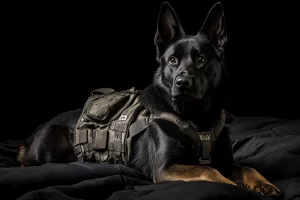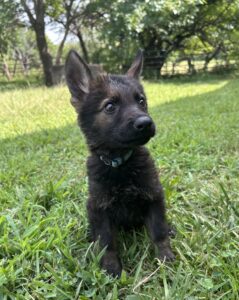The Deployment of Alsatian Shepherds in Military Conflicts
Alsatian Shepherds are older name for German Shepherds. This name dates back to a time in history when great anti-German sentiment existed in Britain and other western countries. A breed with deep historical roots, this noble dog ha left its mark on military operations. Their service began during World War I. It continues to this day. The breed’s physical abilities and intelligence made them indispensable to many military efforts. Military use of these Alsatian Shepherds evolved over time. In early warfare, these dogs were used by scouts. They were effective at clearing out enemy strongholds before their human counterparts approached. In more recent years, military has used the dogs in helping find and locate weapons of mass destruction (WMDs). Here at Czech Working Line, we only breed working line Alsatian Shepherds. Every Alsatian Shepherd for sale we offer are entirely the result of careful selection. Nearly every dog going back generations come from Schutzhund titled dogs. There is hardly a single dog for generations that has not been titled. What a huge benefit this can be! While our bloodlines owe much the the Czech military in the development of these great dogs, we realize many of the people who get to our site are not military people, but rather, everyday people like you and I. And these dogs are great for us as well. We hope as you read about the development of this great breed that the information you learn can be informative and useful.
Early Use During World War I and World War II
German Shepherds played a crucial role in World War I. They carried messages across dangerous battlefields. These dogs also transported supplies to soldiers under fire. The military used them to locate injured soldiers in no man’s land. This saved countless lives during intense battles (Jarrett et al., 2022). French and German forces recognized the need for specialized dog training programs. As a result, canine units were institutionalized to improve efficiency during missions (Pearson, 2013). The role of German Shepherds expanded in World War II. Nazi Germany trained these dogs for guarding prisoners and scouting enemy positions. The Allies used them for patrolling and detecting landmines. U.S. programs, such as “Dogs for Defense,” enlisted thousands of dogs. These dogs patrolled beaches and airfields to protect against potential threats (Jarrett et al., 2022). Some, like Chips, a German Shepherd-Collie mix, performed acts of heroism. Chips famously captured a machine gun nest during the invasion of Sicily (Miller et al., 2018). This highlighted the breed’s ability to assist soldiers in the most dangerous situations.
Physical Capabilities in Combat
German Shepherds are well-suited to military work because of their physical structure. Their powerful legs give them the strength to excel in tracking and patrols. Research shows their body mechanics allow them to sustain long periods of work. Their physical endurance makes them ideal for guarding installations and engaging in physically demanding tasks (PLOS ONE, 2022). Additionally, their intelligence allows them to learn complex commands quickly. This ensures they perform effectively even in high-pressure situations (Harvey et al., 2019). These physical capabilities make this this breed a great fit not only for military, but as home protection dogs. For our family here at Czech Working Lines, while some of our Alsatian Shepherds for sale go to more serious homes, many find their forever homes with everyday people like you and I.
Service in both the Cold War and Modern Deployment
German Shepherds also served during the Cold War. They were used to guard military installations and for reconnaissance missions. Their role expanded further during the Vietnam War. In Vietnam, these dogs detected hidden tunnels and enemy traps. Scout dog teams saved lives by providing early warning of approaching danger (Walker & White, 2019). These successes shaped modern military canine programs. The U.S. military refined its training techniques to improve the dogs’ performance (Fraser, 2017). Today, German Shepherds remain essential to military operations. They assist in locating explosives, narcotics, and other dangerous materials. Advances in veterinary care allow these dogs to operate in harsh environments. They also support search-and-rescue missions in disaster zones. Retired military dogs often continue their bond with handlers through adoption programs. This practice acknowledges the deep connection between handlers and their canine partners (Journal of Military History, 2024).
Conclusion
Alsatian Shepherds have demonstrated their value across multiple wars. Their role has evolved, but their contributions remain unmatched. From the trenches of World War I to modern counter-terrorism, these dogs continue to serve with distinction. Their legacy in military service will undoubtedly endure. If you have landed on our site a military or law enforcement searching for an Alsatian Shepherd for sale, we look forward to hearing from you. Or, if you are simply a GSD enthusiast and looking for something really great, we are right there with you. A good portion of our Alsatian Shepherds for sale end up in homes were people just want a really bred dog with great instincts. These dogs love like no other. They will bond to your family. And it has been bred for decades for them to instinctually protect!
Bibliography
Fraser, D. (2017). “Animal Behavior, Ethics, and Policy in Livestock Protection.” Animal Welfare, 26(2), 171-180.
Harvey, N. D., Craigon, P. J., Blythe, S. A., England, G. C. W., & Asher, L. (2019). “Traumatic Injuries in Roaming Dogs: An Analysis of Veterinary Case Records.” Preventive Veterinary Medicine, 167, 1-8.
Jarrett, C. L., Brathwaite, M., & Holladay, S. D. (2022). “Working Dog Service, Harmful Agent Exposure, and Decontamination.” Frontiers in Veterinary Science, 9, 892998.
Journal of Military History. (2024). “The Evolution of Military Working Dogs.” Journal of Military History.
Miller, D. A., DeYoung, C. A., & Fulbright, T. E. (2018). “Legal Implications of Livestock Guardian Dog Roaming.” Rangeland Ecology & Management, 71(2), 231-236.
Pearson, C. (2013). “Dogs in the Trenches of World War I.” JSTOR Daily.
PLOS ONE. (2022). “Inertial Properties of the German Shepherd Dog.” PLOS ONE.
Project MUSE. (2022). “From Mascot to Marine: The Long Walk to the American Military Dog Program.” Journal of Army History.
Walker, J., & White, P. (2019). “The Role of Livestock Guardian Dogs in Modern Farming.” Applied Animal Behaviour Science, 215, 1-10.




